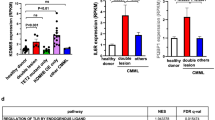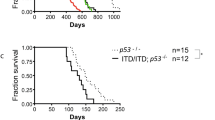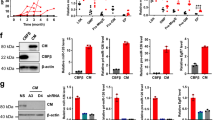Abstract
Chronic lymphocytic leukemia (CLL) patients with deletion of chromosome 17p, where the p53 gene is located, often develop more aggressive disease with poor clinical outcomes. To investigate the underlying mechanisms for the highly malignant phenotype of 17p- CLL and to facilitate in vivo evaluation of potential drugs against CLL with p53 deletion, we have generated a mouse model with TCL1-Tg:p53−/− genotype. These mice develop B-cell leukemia at an early age with an early appearance of CD5+/IgM+ B cells in the peritoneal cavity and spleen, and exhibit an aggressive path of disease development and drug resistance phenotype similar to human CLL with 17p deletion. The TCL1-Tg:p53−/− leukemia cells exhibit higher survival capacity and are more drug resistant than the leukemia cells from TCL1-Tg:p53wt mice. Analysis of microRNA expression reveals that p53 deletion resulted in a decrease of miR-15a and miR-16-1, leading to an elevated expression of Mcl-1. Primary leukemia cells from CLL patients with 17p deletion also show a decrease in miR-15a/miR-16-1 and an increase in Mcl-1. Our study suggests that the p53/miR15a/16-1/Mcl-1 axis may be an important pathway that regulates Mcl-1 expression and contributes to drug resistance and aggressive phenotype in CLL cells with loss of p53.
This is a preview of subscription content, access via your institution
Access options
Subscribe to this journal
Receive 12 print issues and online access
$259.00 per year
only $21.58 per issue
Buy this article
- Purchase on Springer Link
- Instant access to full article PDF
Prices may be subject to local taxes which are calculated during checkout








Similar content being viewed by others
References
Caligaris-Cappio F, Gobbi M, Bofill M, Janossy G . Infrequent normal B lymphocytes express features of B-chronic lymphocytic leukemia. J Exp Med 1982; 155: 623–628.
Landis SH, Murray T, Bolden S, Wingo PA . Cancer statistics, 1998. CA Cancer J Clin 1998; 48: 6–29.
Zenz T, Mertens D, Dohner H, Stilgenbauer S . Importance of genetics in chronic lymphocytic leukemia. Blood Rev 2011; 25: 131–137.
Dohner H, Stilgenbauer S, Benner A, Leupolt E, Krober A, Bullinger L et al. Genomic aberrations and survival in chronic lymphocytic leukemia. N Engl J Med 2000; 343: 1910–1916.
Leonard CJ, Canman CE, Kastan MB . The role of p53 in cell-cycle control and apoptosis: implications for cancer. Important Adv Oncol 1995;, 33–42.
Zenz T, Krober A, Scherer K, Habe S, Buhler A, Benner A et al. Monoallelic TP53 inactivation is associated with poor prognosis in chronic lymphocytic leukemia: results from a detailed genetic characterization with long-term follow-up. Blood 2008; 112: 3322–3329.
Zenz T, Frohling S, Mertens D, Dohner H, Stilgenbauer S . Moving from prognostic to predictive factors in chronic lymphocytic leukaemia (CLL). Best Pract Res Clin Haematol 2010; 23: 71–84.
Gonzalez D, Martinez P, Wade R, Hockley S, Oscier D, Matutes E et al. Mutational status of the TP53 gene as a predictor of response and survival in patients with chronic lymphocytic leukemia: results from the LRF CLL4 trial. J Clin Oncol 2011; 29: 2223–2229.
de Viron E, Michaux L, Put N, Bontemps F, van den Neste E . Present status and perspectives in functional analysis of p53 in chronic lymphocytic leukemia. Leuk Lymphoma 2012; 53: 1445–1451.
Bichi R, Shinton SA, Martin ES, Koval A, Calin GA, Cesari R et al. Human chronic lymphocytic leukemia modeled in mouse by targeted TCL1 expression. Proc Natl Acad Sci USA 2002; 99: 6955–6960.
Planelles L, Carvalho-Pinto CE, Hardenberg G, Smaniotto S, Savino W, Gomez-Caro R et al. APRIL promotes B-1 cell-associated neoplasm. Cancer Cell 2004; 6: 399–408.
Zapata JM, Krajewska M, Morse HC 3rd, Choi Y, Reed JC . TNF receptor-associated factor (TRAF) domain and Bcl-2 cooperate to induce small B cell lymphoma/chronic lymphocytic leukemia in transgenic mice. Proc Natl Acad Sci USA 2004; 101: 16600–16605.
Costinean S, Zanesi N, Pekarsky Y, Tili E, Volinia S, Heerema N et al. Pre-B cell proliferation and lymphoblastic leukemia/high-grade lymphoma in E(mu)-miR155 transgenic mice. Proc Natl Acad Sci USA 2006; 103: 7024–7029.
Raveche ES, Salerno E, Scaglione BJ, Manohar V, Abbasi F, Lin YC et al. Abnormal microRNA-16 locus with synteny to human 13q14 linked to CLL in NZB mice. Blood 2007; 109: 5079–5086.
Santanam U, Zanesi N, Efanov A, Costinean S, Palamarchuk A, Hagan JP et al. Chronic lymphocytic leukemia modeled in mouse by targeted miR-29 expression. Proc Natl Acad Sci USA 2010; 107: 12210–12215.
Robertson LE, Plunkett W, McConnell K, Keating MJ, McDonnell TJ . Bcl-2 expression in chronic lymphocytic leukemia and its correlation with the induction of apoptosis and clinical outcome. Leukemia 1996; 10: 456–459.
Pepper C, Lin TT, Pratt G, Hewamana S, Brennan P, Hiller L et al. Mcl-1 expression has in vitro and in vivo significance in chronic lymphocytic leukemia and is associated with other poor prognostic markers. Blood 2008; 112: 3807–3817.
Willis SN, Chen L, Dewson G, Wei A, Naik E, Fletcher JI et al. Proapoptotic Bak is sequestered by Mcl-1 and Bcl-xL, but not Bcl-2, until displaced by BH3-only proteins. Genes Dev 2005; 19: 1294–1305.
Zenz T, Mohr J, Edelmann J, Sarno A, Hoth P, Heuberger M et al. Treatment resistance in chronic lymphocytic leukemia: the role of the p53 pathway. Leuk Lymphoma 2009; 50: 510–513.
Donehower LA, Harvey M, Slagle BL, McArthur MJ, Montgomery CA Jr, Butel JS et al. Mice deficient for p53 are developmentally normal but susceptible to spontaneous tumours. Nature 1992; 356: 215–221.
Cheson BD, Bennett JM, Rai KR, Grever MR, Kay NE, Schiffer CA et al. Guidelines for clinical protocols for chronic lymphocytic leukemia: recommendations of the National Cancer Institute-sponsored working group. Am J Hematol 1988; 29: 152–163.
Trachootham D, Zhang H, Zhang W, Feng L, Du M, Zhou Y et al. Effective elimination of fludarabine-resistant CLL cells by PEITC through a redox-mediated mechanism. Blood 2008; 112: 1912–1922.
Pelicano H, Feng L, Zhou Y, Carew JS, Hileman EO, Plunkett W et al. Inhibition of mitochondrial respiration: a novel strategy to enhance drug-induced apoptosis in human leukemia cells by a reactive oxygen species-mediated mechanism. J Biol Chem 2003; 278: 37832–37839.
Dohner H, Fischer K, Bentz M, Hansen K, Benner A, Cabot G et al. p53 gene deletion predicts for poor survival and non-response to therapy with purine analogs in chronic B-cell leukemias. Blood 1995; 85: 1580–1589.
Enzler T, Kater AP, Zhang W, Widhopf GF 2nd, Chuang HY, Lee J et al. Chronic lymphocytic leukemia of Emu-TCL1 transgenic mice undergoes rapid cell turnover that can be offset by extrinsic CD257 to accelerate disease progression. Blood 2009; 114: 4469–4476.
Huang P, Sandoval A, Van Den Neste E, Keating MJ, Plunkett W . Inhibition of RNA transcription: a biochemical mechanism of action against chronic lymphocytic leukemia cells by fludarabine. Leukemia 2000; 14: 1405–1413.
Aqeilan RI, Calin GA, Croce CM . miR-15a and miR-16-1 in cancer: discovery, function and future perspectives. Cell Death Differ 2010; 17: 215–220.
Wang LL . Biology of osteogenic sarcoma. Cancer J 2005; 11: 294–305.
Hollstein M, Sidransky D, Vogelstein B, Harris CC . p53 mutations in human cancers. Science 1991; 253: 49–53.
Bennett WP, Hollstein MC, Hsu IC, Sidransky D, Lane DP, Vogelstein B et al. Mutational spectra and immunohistochemical analyses of p53 in human cancers. Chest 1992; 101 (3 Suppl): 19S–20S.
Levine AJ, Momand J, Finlay CA . The p53 tumour suppressor gene. Nature 1991; 351: 453–456.
Cordone I, Masi S, Mauro FR, Soddu S, Morsilli O, Valentini T et al. p53 expression in B-cell chronic lymphocytic leukemia: a marker of disease progression and poor prognosis. Blood 1998; 91: 4342–4349.
Levine AJ, Oren M . The first 30 years of p53: growing ever more complex. Nat Rev Cancer 2009; 9: 749–758.
Chipuk JE, Green DR . Dissecting p53-dependent apoptosis. Cell Death Differ 2006; 13: 994–1002.
Vucic D, Dixit VM, Wertz IE . Ubiquitylation in apoptosis: a post-translational modification at the edge of life and death. Nat Rev Mol Cell Biol 2011; 12: 439–452.
Ploner C, Kofler R, Villunger A . Noxa: at the tip of the balance between life and death. Oncogene 2008; 27 (Suppl 1): S84–S92.
Pietrzak M, Puzianowska-Kuznicka M . p53-dependent repression of the human MCL-1 gene encoding an anti-apoptotic member of the BCL-2 family: the role of Sp1 and of basic transcription factor binding sites in the MCL-1 promoter. Biol Chem 2008; 389: 383–393.
Sampath D, Liu C, Vasan K, Sulda M, Puduvalli VK, Wierda WG et al. Histone deacetylases mediate the silencing of miR-15a, miR-16, and miR-29b in chronic lymphocytic leukemia. Blood 2012; 119: 1162–1172.
Calin GA, Croce CM . Chronic lymphocytic leukemia: interplay between noncoding RNAs and protein-coding genes. Blood 2009; 114: 4761–4770.
Merkel O, Asslaber D, Pinon JD, Egle A, Greil R . Interdependent regulation of p53 and miR-34a in chronic lymphocytic leukemia. Cell Cycle 2010; 9: 2764–2768.
Acknowledgements
We thank BA Hayes and R LaPushin for their assistance in handling CLL samples. This work was supported in part by grants CA085563, CA100428 and CA016672 from the National Institutes of Health, grant RP110322 from the Cancer Prevention and Research Institute of Texas (CPRIT), and a grant from the CLL Global Research Foundation.
Author Contributions
Contributions: JL designed and performed research, analyzed data and drafted the manuscript; GC, L F, HP, FW, WZ, MAO, WL performed research and analyzed data; HA performed histology/pathology analysis; CMC contributed TCL1 transgenic mice; MJK identified clinical specimens, designed research and interpreted data; PH directed the study design, data analysis/interpretation and drafted the manuscript.
Author information
Authors and Affiliations
Corresponding author
Ethics declarations
Competing interests
The authors declare no conflict of interest.
Additional information
Supplementary Information accompanies this paper on the Leukemia website
Supplementary information
Rights and permissions
About this article
Cite this article
Liu, J., Chen, G., Feng, L. et al. Loss of p53 and altered miR15-a/16-1→MCL-1 pathway in CLL: insights from TCL1-Tg:p53−/− mouse model and primary human leukemia cells. Leukemia 28, 118–128 (2014). https://doi.org/10.1038/leu.2013.125
Received:
Revised:
Accepted:
Published:
Issue Date:
DOI: https://doi.org/10.1038/leu.2013.125
Keywords
This article is cited by
-
Longitudinal analyses of CLL in mice identify leukemia-related clonal changes including a Myc gain predicting poor outcome in patients
Leukemia (2022)
-
Co-delivery of miRNA-15a and miRNA-16–1 using cationic PEGylated niosomes downregulates Bcl-2 and induces apoptosis in prostate cancer cells
Biotechnology Letters (2021)
-
Systemic depletion of L-cyst(e)ine with cyst(e)inase increases reactive oxygen species and suppresses tumor growth
Nature Medicine (2017)
-
Two mouse models reveal an actionable PARP1 dependence in aggressive chronic lymphocytic leukemia
Nature Communications (2017)
-
TCL1 transgenic mouse model as a tool for the study of therapeutic targets and microenvironment in human B-cell chronic lymphocytic leukemia
Cell Death & Disease (2016)



